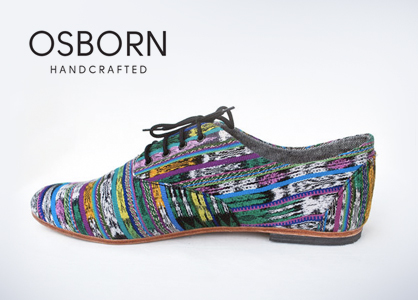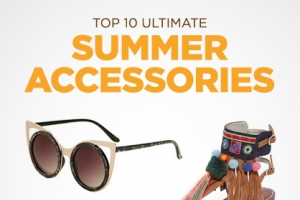Aaron Osborn of Osborn Shoes discusses company’s start
Little did Aaron Osborn know that a trip to Guatemala to help out at his family’s orphanage would turn into a career as a footwear designer. Regularly published in magazines or featured in hip boutiques, Osborn Shoes has gone from a hobby to a fashion enterprise, and Osborn has artisans from South American countries to thank.
After graduating from the Rhode Island School of Design with a focus on painting and printmaking, Osborn decided to venture down south and help out with his parents’ nonprofit endeavor. Right from the start, Osborn found a way to integrate the arts with orphanage life. With the help of the children in the home, he decorated the walls with colorful murals. He also started art classes with the kids, using one of his primary skills: printmaking.
“What kind of led me to where I am now is that I started teaching silk screening with a lot of my classes, which has always been a real fun printing method for me,” he said. “It’s pretty prevalent in Guatemala, so it was really easy to get supplies. We started making shirts and designs, and selling them to people that would visit the home.”
He was impressed by many of the designs that the kids produced.
“There were some that were really awesome,” he said. “One was this really simple moon with stars around it, but the stars were made of square little chunks. This one kid did these palm leaves that looked like paint chips.”
He felt connected to the children in the home and was frustrated when it was time for them to leave. Many didn’t have an education or a job to fall back on, and he worried about their futures.
“I was just watching the kids get institutionalized and graduate from the children’s home and be left (behind),” he said. “Only the brightest kids were getting into universities…the really motivated ones.”
The kids sold the shirts in Antigua, the tourist hub of Guatemala, and were surprised by the demand for their specially designed tees.
“When a visitor would come back wearing the shirt, the kids just couldn’t understand … (They’d ask) ‘Why are they wearing my shirt? My designs are stupid’ and it’s like no, it’s awesome,” Osborn said.
Where did the idea for shoes come in? As with everything in Aaron Osborn’s life, the idea came about serendipitously and (not surprisingly) inspired by his encounter with local artisans.
Osborn and his father changed gears after a natural disaster struck Guatemala in 2005.
“A real pivotal point was when (hurricanes) Katrina and Wilma hit Guatemala,” he said. “It was fairly devastating in terms of mudslides. A whole mountaintop slid onto a village one night.”
The two journeyed across Guatemala, buying supplies and food. Eventually, Osborn started to work as a translator and became friendly with the other translators that would translate Spanish to local dialects.
“I would have lunch with the translators, and a lot of them were either a cobbler or a tailor,” he said. “I’ve always wanted to make clothes and shoes. That was the moment of ‘Hmm. Now I’m meeting the people, so let’s try and do it.’”
The idea for Osborn Shoes was born.
Osborn decided he needed to enlist a partner, so he contacted his friend (now his wife) Carla Venticinque, whom he’d met while growing up in Philadelphia. She eventually brought him back to New York, where they put the business model together.
In 2009, it officially became a business.
They had one cobbler named Berto, who made three to five pairs a week. It obviously wasn’t their prime source of income, and they weren’t sure where the business would take them. The two spent their odd hours as art directors for film and TV. When the economy crashed, their art direction jobs came to a standstill, causing Osborn and Venticinque to revisit their brand.
The shoes take the shape of the classic oxford, but have a hippie, handcrafted vibe to them, vibrant in Guatemalan indigenous prints. Now they’ve added two new shapes: a boot and a slip-on.
“I’ve always loved folk textile from around the world,” Osborn said. “Guatemala happens to have one of the largest indigenous American populations.”
He repurposed materials from skirts called “Cortes,” shirts and blankets to use in his shoes.
The only machine used to make the footwear is a sewing machine.
“Each shoe is hand-cut, hand-sewn and hand-cobbled,” he said. “We wanted to embody that feeling of a work of art.”
Each artisan signs the shoes.

“I really like giving people credit,” the co-founder said. “When they sign the shoe, it’s just like ‘That’s your shoe and it’s good.’”
In the last year, they’ve gone from one cobbler to 34 workers in Guatemala. They all work full time, 40 hours a week – which Osborn is very proud of. He told a story of a woman that works for him who was able to purchase her daughter a laptop. Not only can she buy things previously unattainable, she can also pay for her daughter to attend a private school – the only type of school that empower kids in Guatemala to reach a university-level education.
“My vision is just the more people I can hire, the better. It’s already been really fun to see,” he said. “It’s been a year now with this group of people, and just to see what they’ve done with a full-time, really well-paid job…(they) didn’t have that opportunity before.”
Osborn and Venticinque are in the midst of starting to debut their pieces in collections. In the beginning, they posted shoes to their website as they made them, but now, Osborn said, he thinks it is important that they release in collections.
For more information about their Spring 2011 Collection, visit their website at www.osborndesign.com.
Tagged in: lux exclusives, footwear, travel, shoes, nonprofit, guatemala,

Osborn/PurpleNeon



